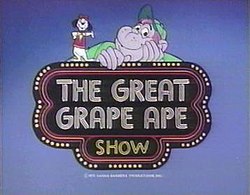Premise
The title character is The Great Grape Ape (voiced by Bob Holt), who is a 40 ft (12 m) tall purple gorilla with the mind of a child. His catch phrase is saying his name twice ("Grape Ape, Grape Ape") after anything anyone says, usually as a form of agreement or acknowledgement of what was said. He travels the countryside with his canine pal Beegle Beagle (voiced by Marty Ingels), whom he calls "Beegly Beagly". [2]
Grape Ape's immense size tends to initially shock and frighten those unfamiliar with him, and his presence alone has often terrified people and animals, causing them to run off screaming invariably: "YEOW! A gorill-ill-ill-ill-la!". The only exception to this was the character Rosie O'Lady (voiced by Janet Waldo), who appeared in Episode 11, "The Indian Grape Call". When asked by Beagle why she did not yell in fear like everyone else did upon seeing Grape Ape, she simply said, "You've seen one 40-foot purple ape, you've seen them all". In "Ali Beagle and the Forty Grapes", a wooden city limits sign reacted to Grape Ape's presence (after "overhearing" that no one else had) by progressively displaying the "YEOW!" phrase, with Beegle reading aloud as the sign changed, unfolding additional segments for the several "ill[a]" syllables (after which it folded itself up and hopped away in fear).
Grape Ape and his friend Beegle Beagle usually ride around in a small yellow van driven by Beegle Beagle with Grape Ape sitting on the roof which can somehow support his weight. A recurring bit of business would be for him to "rev up" the tiny vehicle like a child with a friction toy, then hop aboard as the van would start on its way. Also, Grape Ape's steps would often bounce Beegle into the air, where his legs would keep walking without breaking stride.
Given his size, Grape Ape's sneezes were equivalent to a hurricane and when he cried which was sometimes when he was homesick for his family, his tears could cause flooding in areas. When he does wrong, he also famously says, "I'm sorry!", which is done so often Beegle Beagle knows when it is coming and sometimes says it along with him, though often in a playful way.
Broadcast history
The Great Grape Ape Show was broadcast in these following formats on ABC: [3]
- The New Tom and Jerry/Grape Ape Show (September 6, 1975 – September 4, 1976, ABC Saturday 8:30-9:30 AM)
- The Tom and Jerry/Grape Ape/Mumbly Show (September 11, 1976 – November 27, 1976, ABC Saturday 8:00-9:00 AM) (reruns of Tom and Jerry and Grape Ape)
- The Great Grape Ape Show (September 11, 1977 – September 3, 1978, ABC Sunday 11:00-11:30 AM) (reruns)
The show was originally broadcast as a segment of Tom & Jerry/Grape Ape Show during the 1975–76 season; for the 1976–77 season, the show became Tom and Jerry/Grape Ape/Mumbly Show , and in 1977–78, The Great Grape Ape Show became its own half-hour show on Sunday mornings. Thirty-two 10-minute installments of Grape Ape were made; two were aired per 30-minute episode.
Grape Ape also appeared as a member of "The Yogi Yahooeys" team on Scooby's All-Star Laff-A-Lympics from 1977 to 1979 and would often team up with Yakky Doodle in sporting competitions. In Britain, the BBC ran The Great Grape Ape with the cartoon series Bailey's Comets during 1977–78. The Tom & Jerry Show also appeared elsewhere in the BBC schedules, whereas the other part of the U.S. Saturday fare, Mumbly was shown by ITV.
Like many animated series created by Hanna-Barbera in the 1970s, the show contained a laugh track created by the studio.
This page is based on this
Wikipedia article Text is available under the
CC BY-SA 4.0 license; additional terms may apply.
Images, videos and audio are available under their respective licenses.
